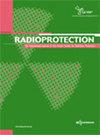新型放射防护设备对经皮冠状动脉介入手术参与者降低辐射的影响
IF 1.8
4区 医学
Q4 ENVIRONMENTAL SCIENCES
引用次数: 0
摘要
背景:经皮冠状动脉介入手术(PCI)中电离辐射对医务人员的危害是所有介入手术中最大的,且危害越来越大,这一现象已受到各国研究者的重视。辐射防护屏蔽设备是一种公认的有效措施,但其防护性能与各种介入程序适用性差有关。本研究的目的是尝试开发一种新型的PCI放射防护屏蔽设备,并测量其有效性和适用性。方法:本研究建立PCI放射防护舱,采用DSA机透视和cine模式,比较实验组(放射防护舱)与对照组(当前正常放射防护)的有效性。收集231个辐射强度数据,在标准化患者周围设置点,210个点分布在治疗床周围的垂直线上,21个点均匀分布在患者的甲状腺、头部和性腺区。结果:基于影像模式,两组患者左、右、足、头面、性腺区域辐射强度比较,差异均有统计学意义(Z=-6.645, -5.615, -6.204, -2.647, -2.882, P<0.05)。基于透视模式,两组患者左、右、足、性腺区域的辐射强度差异有统计学意义(Z=-6.060, -5.083, -5.203, -2.887, P<0.05)结论:放射防护舱可在不影响手术的情况下有效降低患者常规站立区及辐射敏感区辐射强度,在PCI手术中可得到大力推广。本文章由计算机程序翻译,如有差异,请以英文原文为准。
Effect of new radioprotective equipment on decreasing radiation of participants in percutaneous coronary interventional procedure
Background: The hazard of ionizing radiation to medical staff in Percutaneous Coronary Interventional procedure (PCI) is the largest among all interventional procedures and increasing, this phenomenon has received the attention of researchers in various countries. Radiation protective shielding equipment is an accepted effective measure, but protective performance is associated with poor applicability for diverse interventional procedures. The aim of this study attempted to develop new radioprotective shielding equipment for PCI and measure its effectiveness and applicability.
Methods: This study established a radioprotective cabin for PCI and used fluoroscopy and cine modes of DSA machine to compare the effectiveness between the experimental group (radioprotective cabin) and control group (current normal radioprotection). A 231 radiation intensity data collected, dots were set around the standardized patient, 210 points were distributed on the vertical plane around the therapy bed, and 21 points were evenly distributed in the patient's thyroid, head, and gonadal area.
Results: Based on cine modes, there were statistically significant differences between the 2 groups of the radiation intensities in the left plane, right plane, foot plane, head and face area, and the gonads area (Z=-6.645, -5.615, -6.204, -2.647, -2.882, P<0.05). Based on fluoroscopy modes, there were statistically significant differences between 2 groups of the radiation intensities in the left plane, right plane, foot plane, and gonads area (Z=-6.060, -5.083, -5.203, -2.887, P<0.05)
Conclusion: The radioprotective cabin can effectively reduce the radiation intensity in the routine standing area and radiation-sensitive areas of the patient without affecting the operation, which can be strongly promoted in PCI procedure.
求助全文
通过发布文献求助,成功后即可免费获取论文全文。
去求助
来源期刊

Radioprotection
ENVIRONMENTAL SCIENCES-PUBLIC, ENVIRONMENTAL & OCCUPATIONAL HEALTH
CiteScore
3.30
自引率
54.50%
发文量
35
审稿时长
>12 weeks
期刊介绍:
Radioprotection publishes articles on all aspects of radiological protection, including non-ionising as well as ionising radiations. Fields of interest range from research, development and theory to operational matters, education and training. The very wide spectrum of its topics includes (theoretical and practical aspects): dosimetry, instrument development, specialized measuring techniques, epidemiology, biological effects (in vivo and in vitro) and risk and environmental impact assessments.
 求助内容:
求助内容: 应助结果提醒方式:
应助结果提醒方式:


